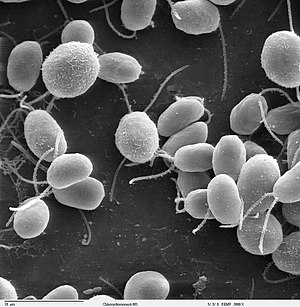Chlamydomonas reinhardtii
| Chlamydomonas reinhardtii | ||||||||||||
|---|---|---|---|---|---|---|---|---|---|---|---|---|

SEM image of Chlamydomonas reinhardtii |
||||||||||||
| Systematics | ||||||||||||
|
||||||||||||
| Scientific name | ||||||||||||
| Chlamydomonas reinhardtii | ||||||||||||
| PA Dangeard |
Chlamydomonas reinhardtii is a unicellular green algae from the genus Chlamydomonas . It wasselectedas Alga of the Year 2014by the Phycology Section of the German Botanical Society .
description


1. Scourge , 2. Mitochondrion , 3. Contractile vacuole , 4. Eye spot , 5. Cup- shaped chloroplast , 6. Golgi apparatus , 7. Starch granules, 8. Pyrenoid , 9. Vacuole , 10. Cell nucleus , 11th century . endoplasmic reticulum , 12, cell membrane 13 cell wall
Chlamydomonas reinhardtii is a 3 to 10 micrometer large envelope flagellate with an ovoid shape. The two equally long ( isocontact ) flagella are used for locomotion. The beatings of the flagella occur one after the other, with a slight delay. This results in a superimposition of their forward movement through a rotation around the longitudinal axis of the alga with a frequency of around 1 Hertz . The movement of the cell is light-controlled.
The cell membrane is not thickened into a papilla at the front. The chloroplast has a large pyrenoid .
There is an eye spot (stigma) about 1 micrometer in diameter. It is colored orange by embedded carotenoids and is easily recognizable. The eye spot is about 10 micrometers from the flagella, slightly above the cell equator. As photoreceptor are rhodopsin -like proteins called channelrhodopsins , stored therein.
habitat
The species lives in fresh water; it is mainly found in small, nutrient-rich water bodies. It is spread all over the world.
Reproduction
The alga can reproduce vegetatively as well as sexually through gametes . Sexual reproduction is induced by a lack of nutrients (particularly a lack of nitrogen). The zygote is the only diploid stage that survives adverse circumstances and, when germinating after meiosis, produces haploid offspring.
Light-controlled behavior
Chlamydomonas reinhardtii has a light-sensitive device for phototaxis with the eye spot . The alga can determine the direction and intensity of incident light. At low illuminance it swims towards the light source, at high intensity it swims away from it. This optimizes their photosynthesis and thus cell nutrition. The alga can live both phototrophically (using light) and heterotrophically (on nutrient medium).
Importance as a research object
The flagella of C. reinhardtii have the same structure as those of human sperm and many other living beings. This alga was chosen as a model organism for studying the structure and function of the flagella because it is very easy to cultivate and because a pH shock can induce it to shed the flagella.
The genome of C. reinhardtii has been completely sequenced. For research purposes, many different mutants of the wild type were bred, which for example have cell wall defects or are "blind".
One research focus is the genetic modification of C.reinhardtii to strains that can produce hydrogen in an industrially usable amount. In parallel, there are a number of scientific projects to develop high-performance bioreactors for hydrogen production .
The ability to split cellulose and use it to generate energy also appears interesting . The alga could thus serve as a biocatalyst for the production of cellulosic biofuels (e.g. cellulosic ethanol ).
literature
- Heinz Streble , Dieter Krauter : Life in a drop of water. Microflora and microfauna of freshwater. An identification book. Franckh-Kosmos Verlag, Stuttgart 2008, ISBN 978-3-440-11966-2 .
Individual evidence
- ↑ Phycology Section of the German Botanical Society (DBG) eV: Alga of the year 2014: Chlamydomonas reinhardtii - faster swimmer is the model (press release) ( Memento of the original from March 4, 2016 in the Internet Archive ) Info: The archive link was automatically inserted and not yet checked. Please check the original and archive link according to the instructions and then remove this notice.
- ↑ Photo-orientation of flagellated green algae. ( Memento of the original from April 25, 2013 in the Internet Archive ) Info: The archive link was inserted automatically and has not yet been checked. Please check the original and archive link according to the instructions and then remove this notice. Research project of the University of Erlangen-Nuremberg with a brief description of the state of research, accessed on April 6, 2011.
- ↑ Erhard Kühnle: Study of ionic processes in the phototransduction of the unicellular alga Chlamydomonas reinhardtii . Scientific research contributions Biology / Biochemistry / Chemistry Vol. 47. Verlag Intemann, Prien 1990. ISBN 3-926323-51-5
- ^ Robert Edward Lee: Phycology . 5th ed., Cambridge University Press, Cambridge 2018, p. 3.
- ↑ Merchant et al .; Prochnik, SE; Vallon, O; Harris, EH; Karpowicz, SJ; Witman, GB; Terry, A; Salamov, A et al .: The Chlamydomonas Genome Reveals the Evolution of Key Animal and Plant Functions Science 318 (2007): 245-250. PMC 2875087 (free full text)
- ^ Homepage of the Chlamydomonas Center , accessed on April 6, 2011.
- ↑ Karin Hollricher: Hydrogen from the alga . In: Laborjournal 04/2010. F + R Internet Agentur, Freiburg, German, accessed on April 8, 2011.
- ↑ Olga Blifernez-Klassen, Viktor Klassen u. a .: Cellulose degradation and assimilation by the unicellular phototrophic eukaryote Chlamydomonas reinhardtii. In: Nature Communications. 3, article: 1214, 2012, doi : 10.1038 / ncomms2210 , plants eat plants on plant research.de, accessed on March 3, 2017.
Web links
- Chlamydomonas reinhardtii . In: algaebase.org (English)
